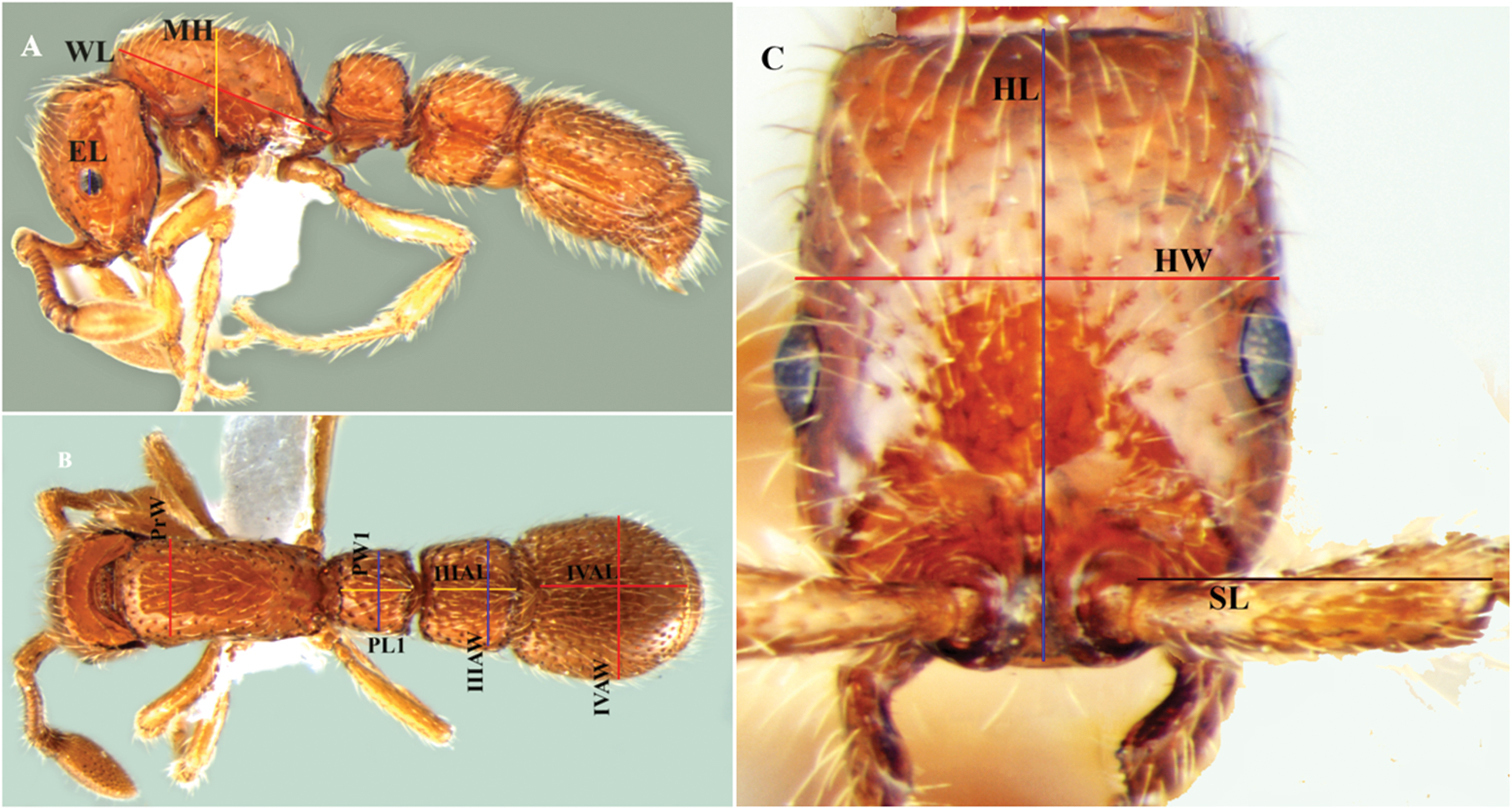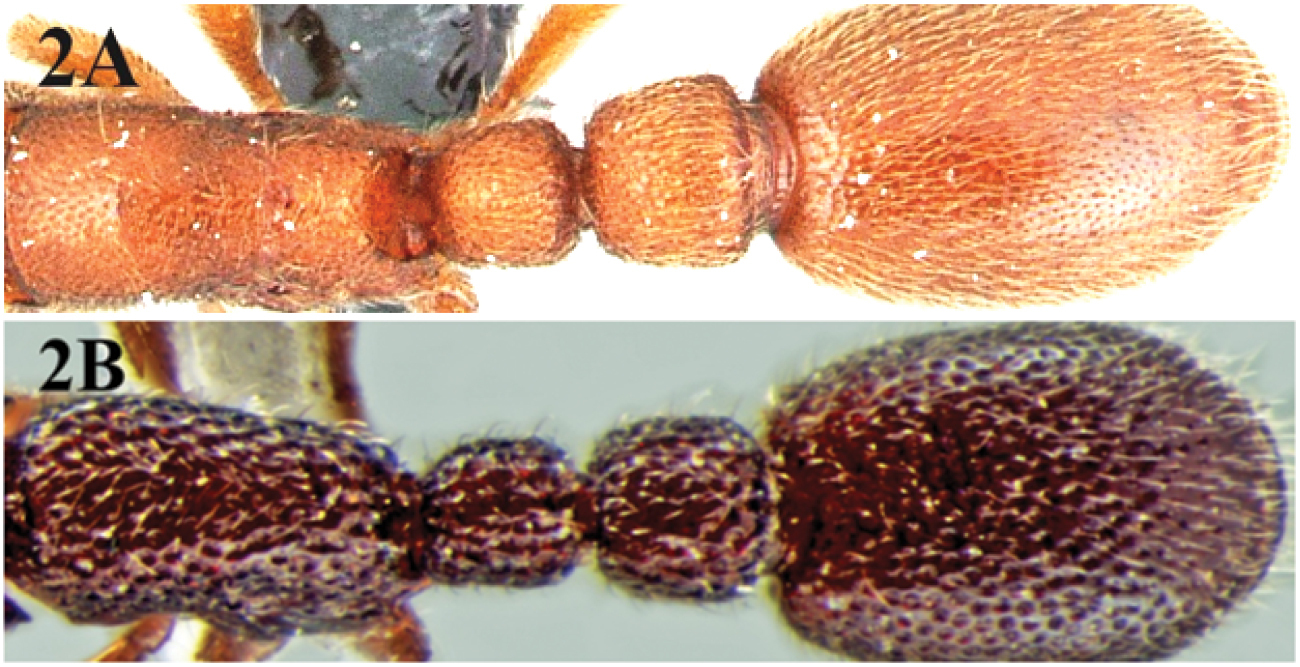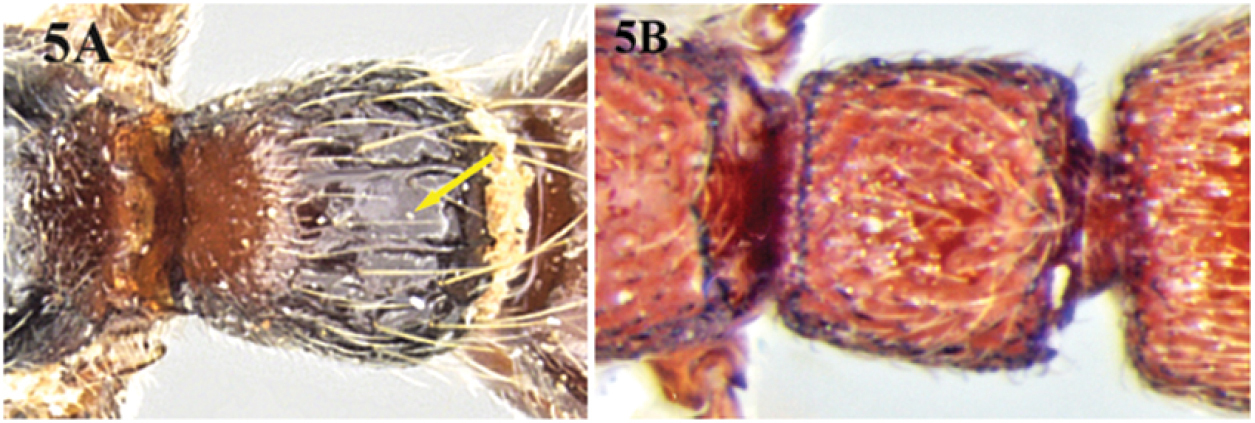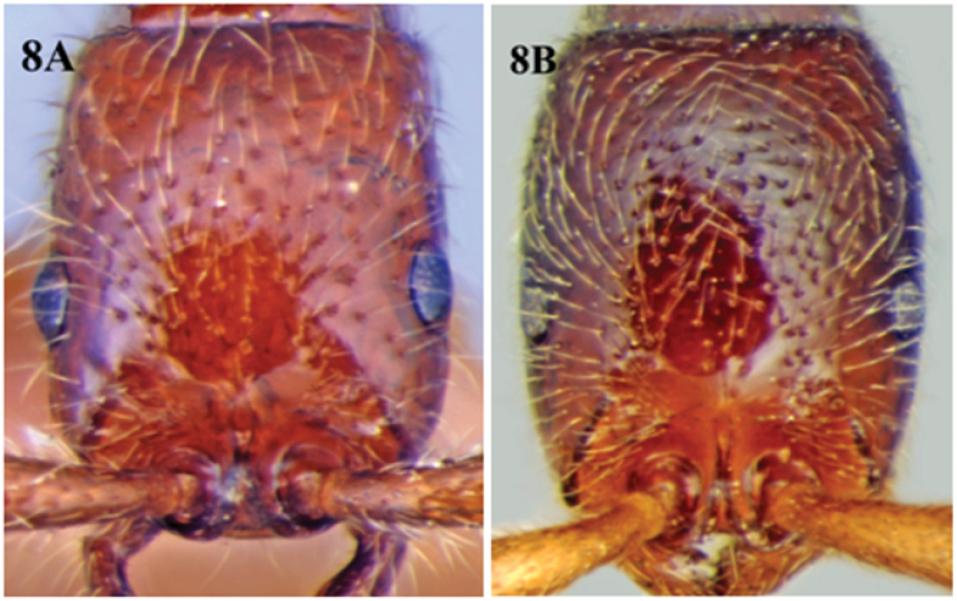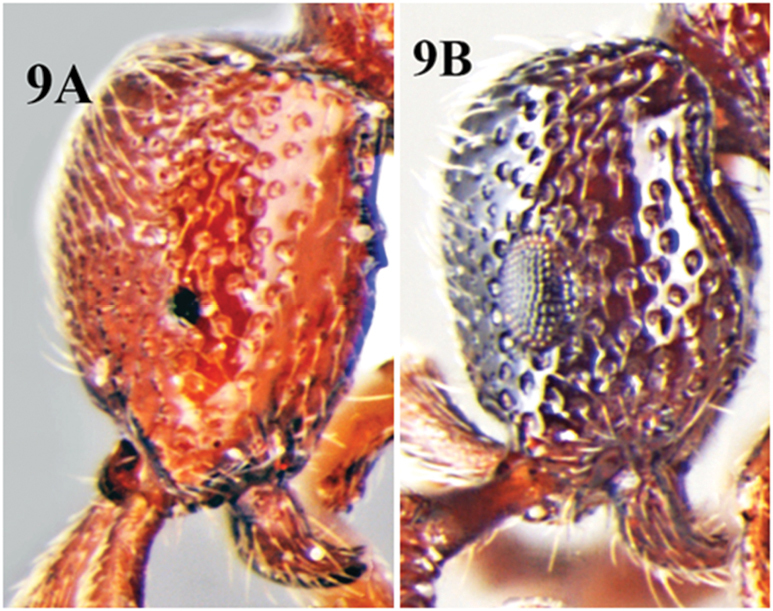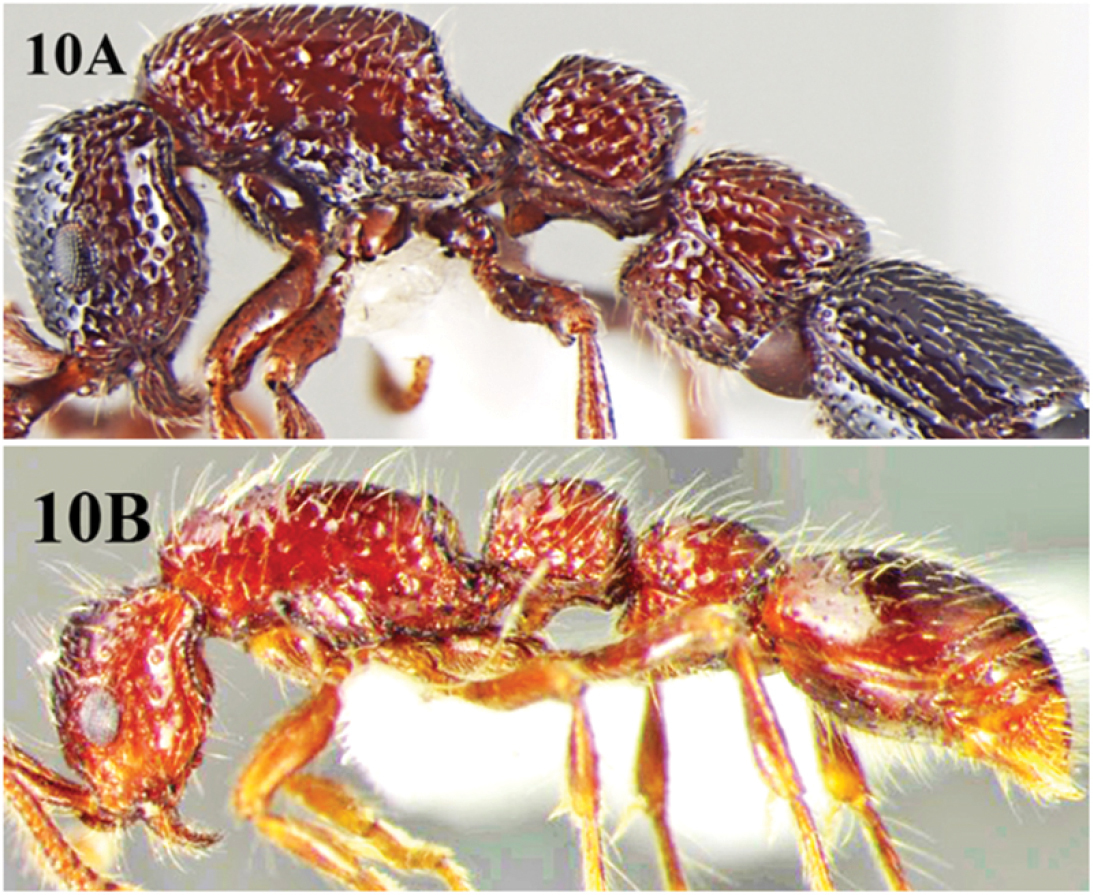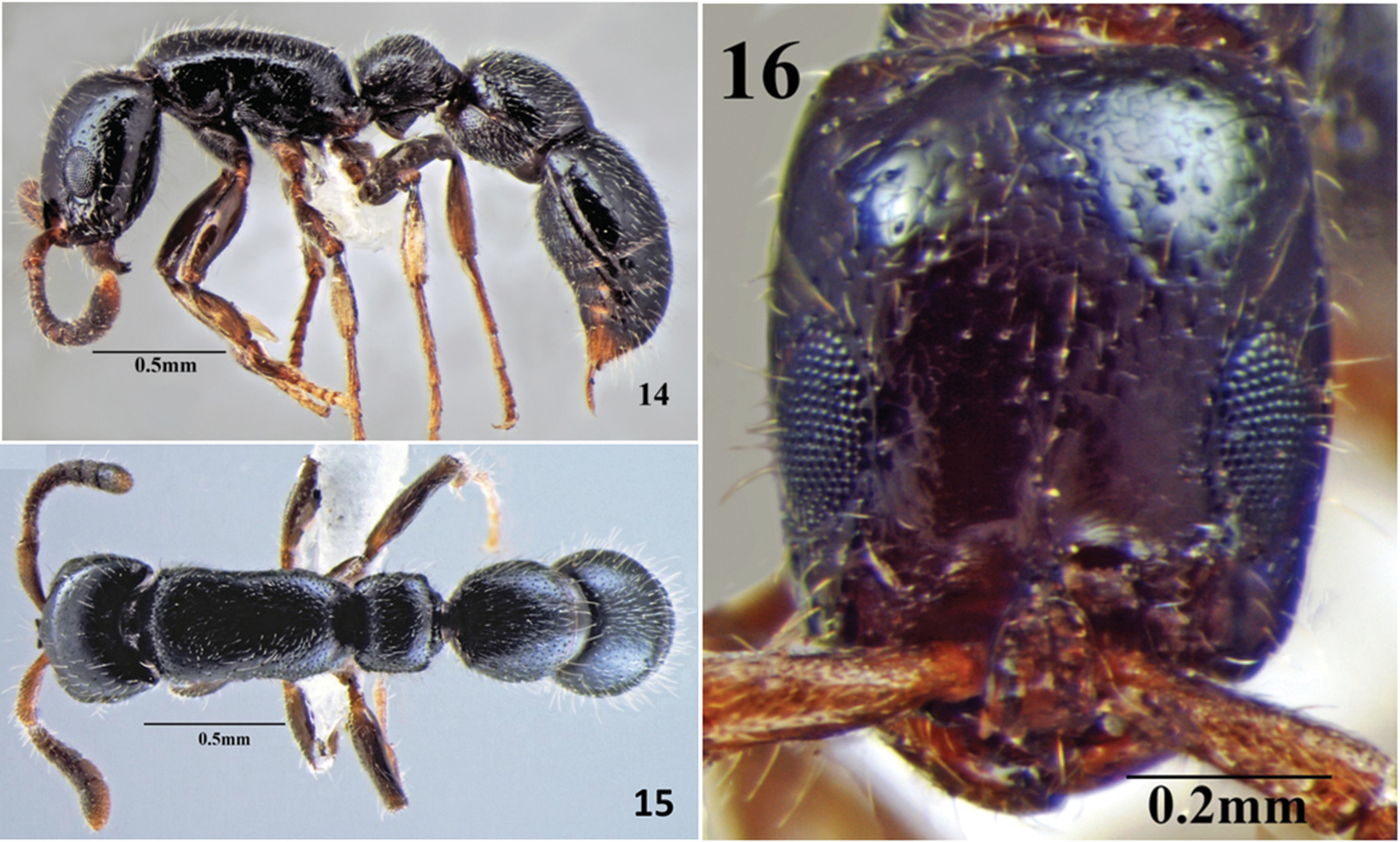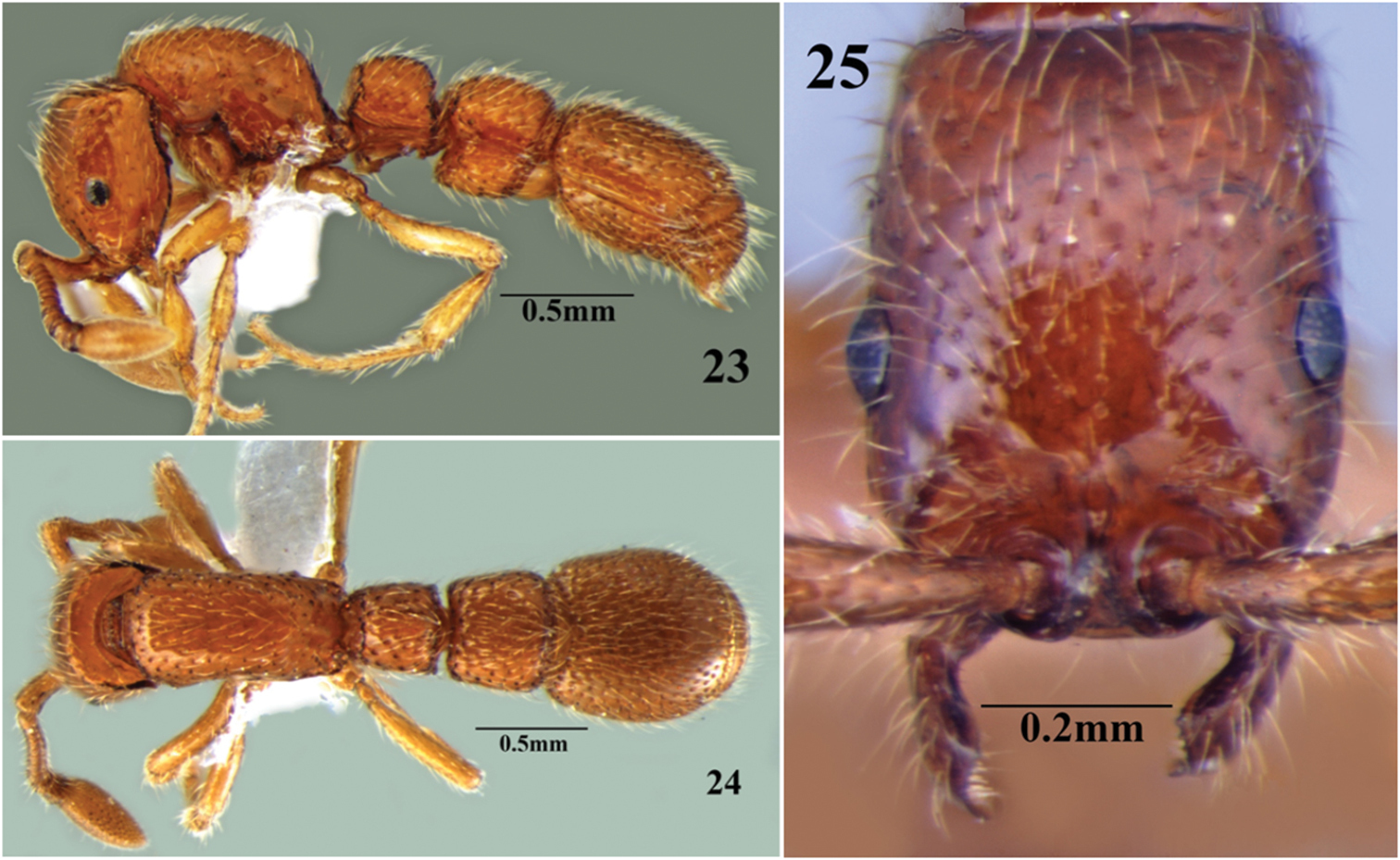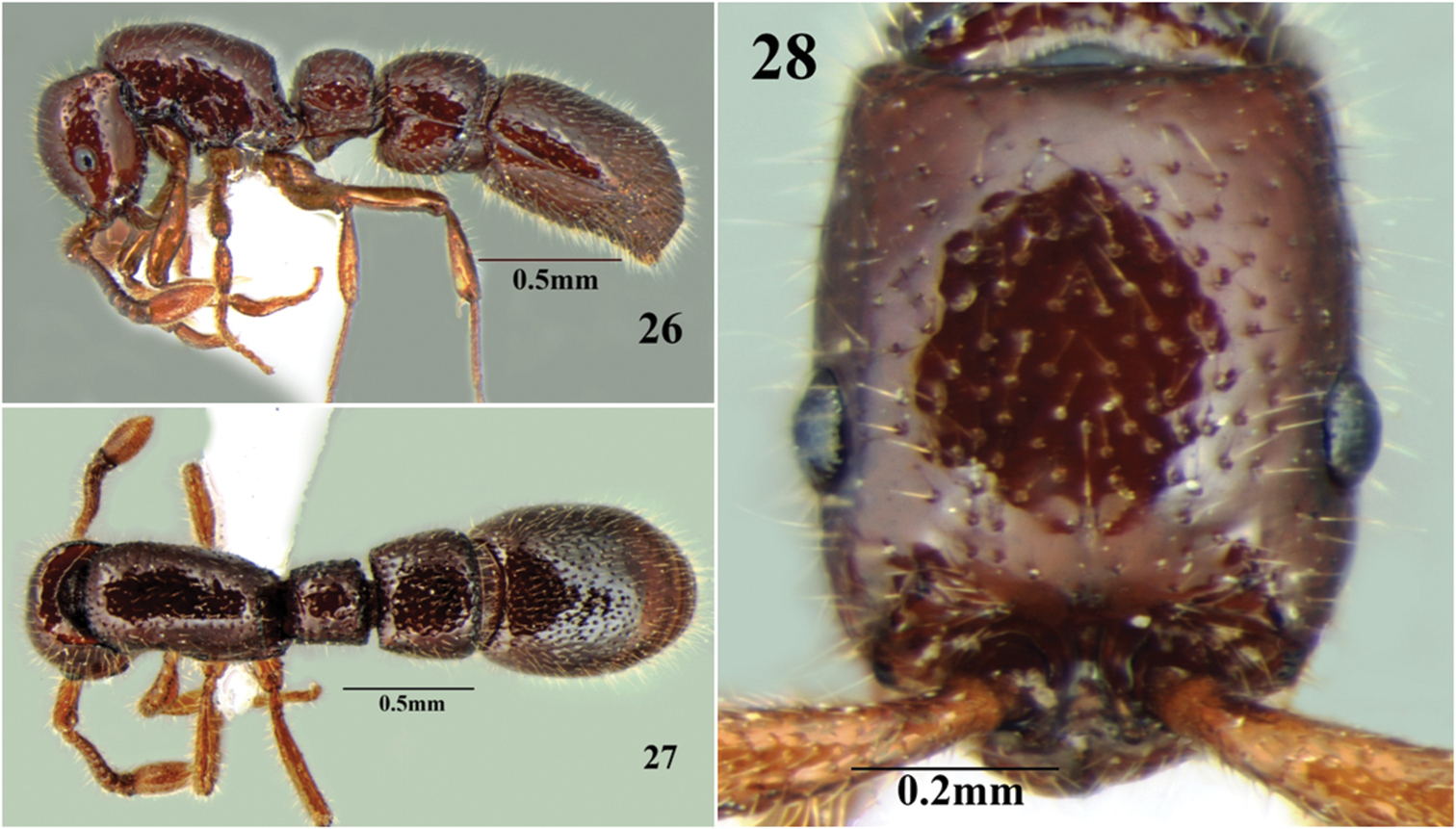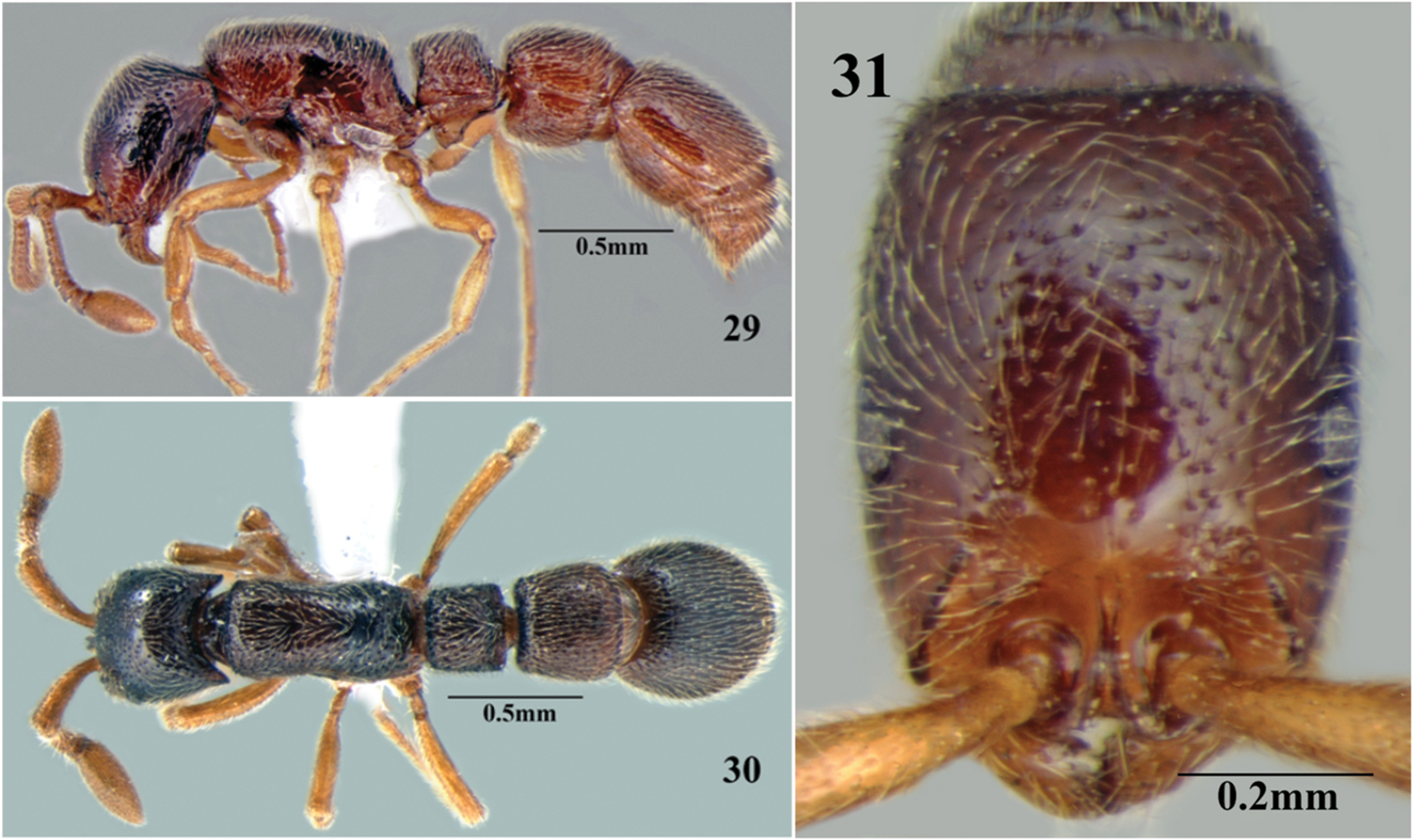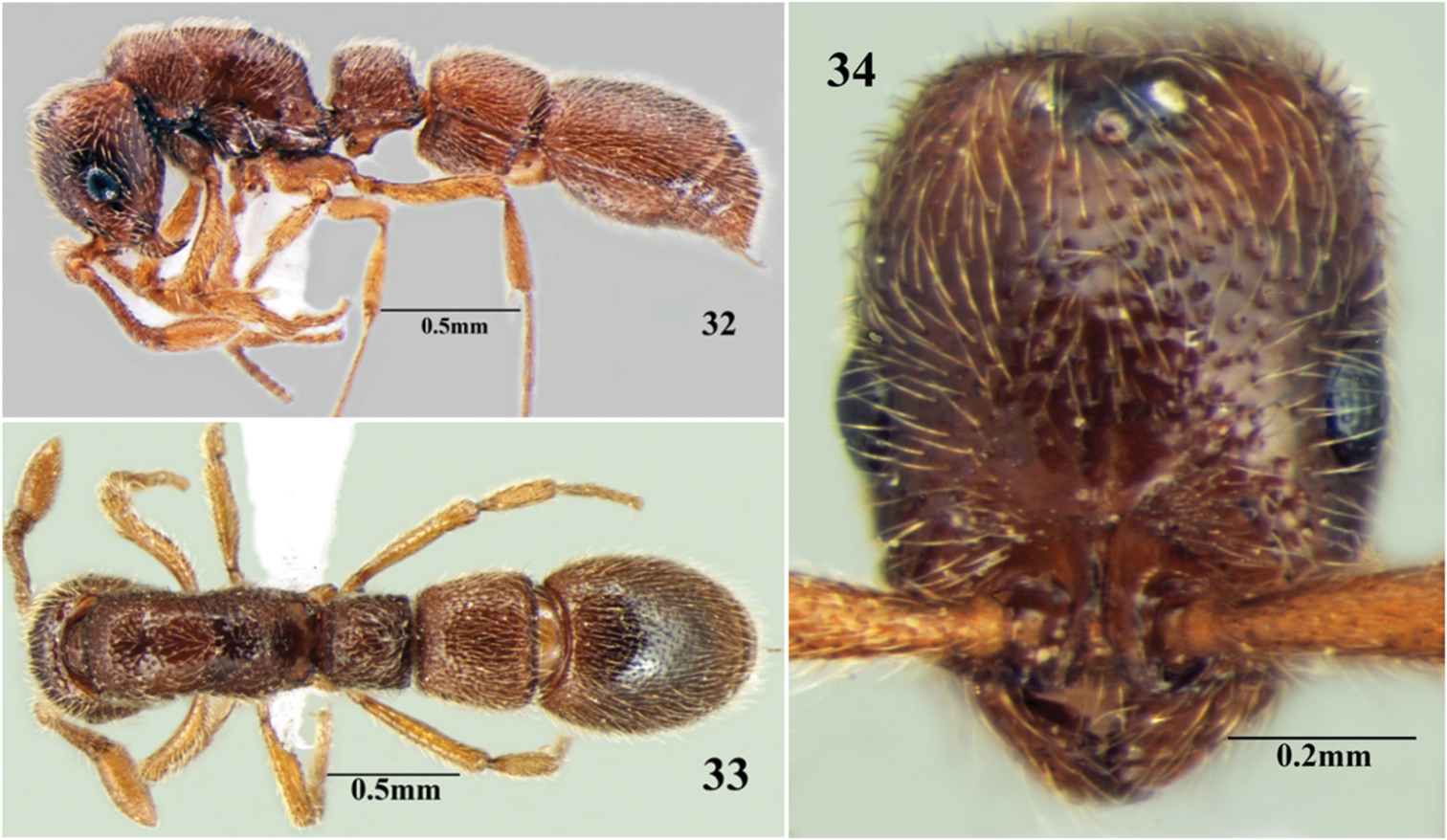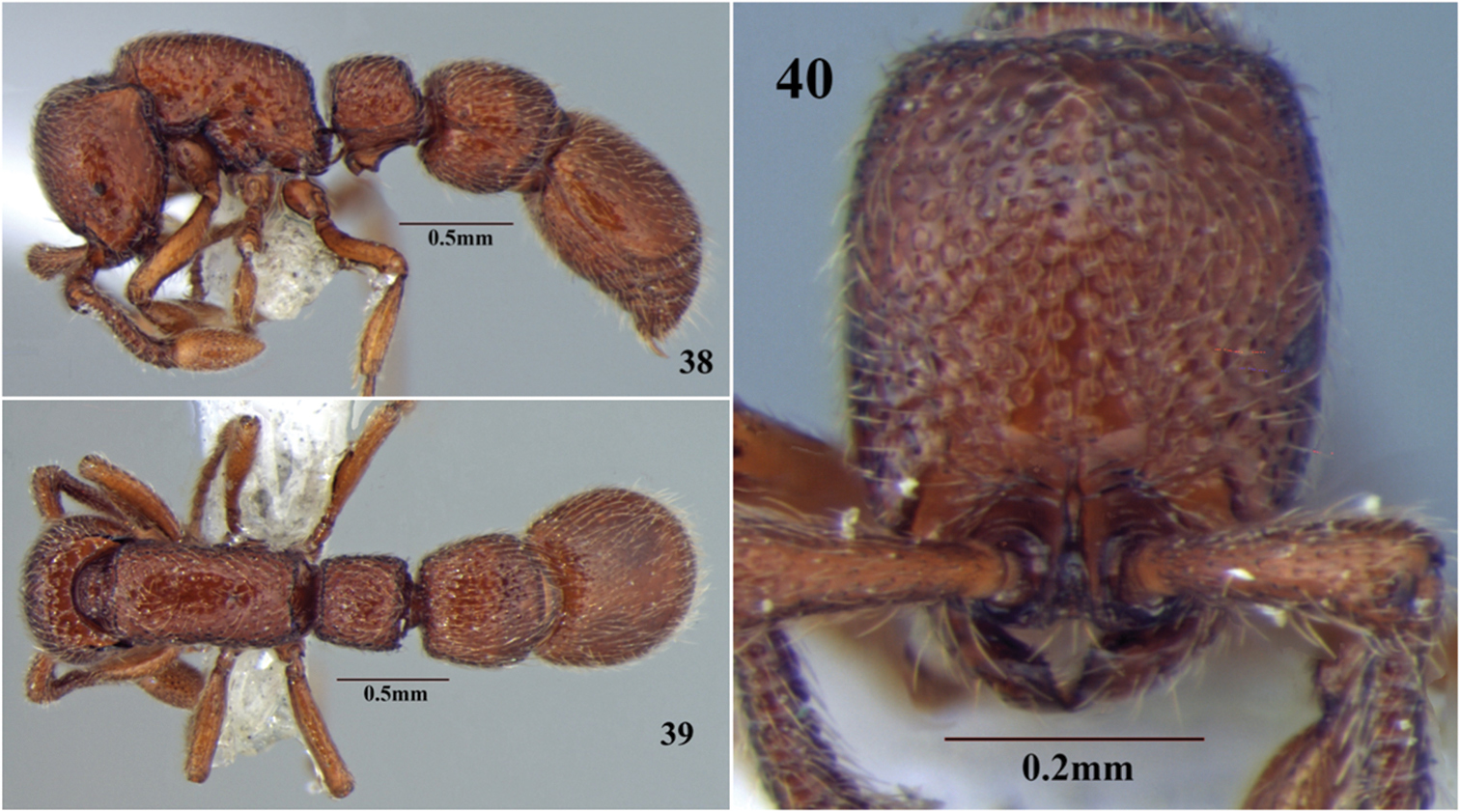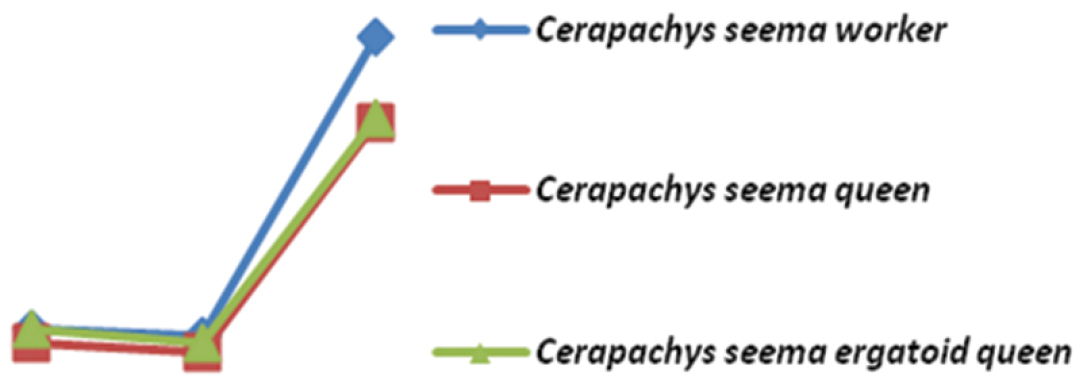






(C) 2013 Himender Bharti. This is an open access article distributed under the terms of the Creative Commons Attribution License 3.0 (CC-BY), which permits unrestricted use, distribution, and reproduction in any medium, provided the original author and source are credited.
For reference, use of the paginated PDF or printed version of this article is recommended.
Citation: Bharti H, Ali Akbar S (2013) Taxonomic studies on the ant genus Cerapachys Smith (Hymenoptera, Formicidae) from India. ZooKeys 336: 79–103. doi: 10.3897/zookeys.336.5719
The Indianspeciesof the ant genus Cerapachys Smith are keyed. Twelve species are recognized of which 6 are described as new. The species are: Cerapachys aitkenii Forel, Cerapachys alii sp. n., Cerapachys anokha sp. n., Cerapachys besucheti Brown, Cerapachys biroi Forel, Cerapachys indicus Brown, Cerapachys longitarsus (Mayr), Cerapachys nayana sp. n., Cerapachys schoedli sp. n., Cerapachys seema sp. n., Cerapachys sulcinodis Emery and Cerapachys wighti sp. n. Geographic distribution and group affinities of the new species are discussed. A revised key to the Indian species is provided. The rare ergatoid queens of Cerapachys nayana, Cerapachys schoedli and Cerapachys seema are reported. Formed in response to selective pressures these ergatoid queens have a significant role in dispersal strategies and contribute much to our understanding of the biology of these ants.
Ants, Cerapachyinae, ergatoid queens, new species, myrmecophagy, India, Formicidae, Cerapachys, key, taxonomy
The ant genus Cerapachys includesmainly myrmecophagous ants which raid the nests of other ants for prey (
Cerapachys in India is currently represented by 6 species (
The specimens were collected by hand and Winkler extraction. Taxonomic analysis was conducted using a Nikon SMZ 1500 stereo zoom microscope. For digital images, an MP evolution digital camera was used on the same microscope with Auto-Montage (Syncroscopy, Division of Synoptics, Ltd.) software. Later, images were cleaned as per requirement with Adobe Photoshop CS6. Description style and morphological terminology for measurements and indices follow
BMNH Natural History Museum, London, U.K.
PUAC Punjabi University Patiala, Ant Collection at Department of Zoology and Environmental Sciences, Punjabi University, Patiala, Punjab, India.
Images illustrating the measurements used. A body in lateral view with measuring lines for EL, MH, and WL B body in dorsal view with measuring lines for PrW, PL1, PW1, IIIAW, IIIAL, IVAW and IVAL C head in full-face view with measuring lines for HL, HW and SL.
| 1 | Antenna 9 segmented | 2 |
| – | Antenna 11 or 12 segmented | 3 |
| 2 | Larger species (HW 0.46–0.49 mm). Sculpture predominantly punctuate (Fig. 2A) | Cerapachys biroi Forel |
| – | Smaller species (HW 0.37–0.39 mm). Sculpture predominantly foveate (Fig. 2B) | Cerapachys alii sp. n. |
|
Figure 2.
A dorsal surface of Cerapachys biroi with conspicuous punctate sculpture B dorsal surface of Cerapachys alii with foveate sculpture. |
||
| 3 | Antenna 11 segmented | Cerapachys besucheti Brown |
| – | Antenna 12 segmented | 4 |
| 4 | Petiole with dorsum rounding into sides; dorsolateral margins absent or vestigial (Fig. 3A) | 6 |
| – | Petiole with strong overhanging dorsolateral margins (Fig. 3B) | 5 |
|
Figure 3.
A petiole of Cerapachys schoedli with dorsum rounding into sides without overhanging dorsolateral margins B petioleof Cerapachys nayana with strong overhanging dorsolateral margins. |
||
| 5 | Head brown, trunk red or brown, petiole and postpetiole light to dark reddish, gaster brown or black. Dorsal surface of body shiny, with widely scattered, indistinct punctures, throughout the body (Fig. 4A) | Cerapachys longitarsus (Mayr) |
| – | Head, trunk, petiole and postpetiole black coloured. Dorsal surface of body shiny, with widely scattered, indistinct punctures, mostly confined to postpetiole (Fig. 4B) | Cerapachys nayana sp. n. |
|
Figure 4.
A. body of Cerapachys longitarsus in lateral view illustrating the characteristic bicolouration B uniformly coloured body of Cerapachys nayana in lateral view. |
||
| 6 | Dorsal surface of petiolar node with a smooth, median area (Fig. 5A) | Cerapachys sulcinodis Emery |
| – | Dorsal surface of petiolar node rounded and punctuate, without a differentiated median smooth area (Fig. 5B) | 7 |
|
Figure 5.
A petiolar node of Cerapachys sulcinodis with smooth median area B petiolar node of Cerapachys wighti without any median smooth area. |
||
| 7 | Punctures on dorsum of head relatively small, their diameter smaller than the average distance separating them (Fig. 6A) | 8 |
| – | Punctures on head dorsum large, foveiform, dense, their diameter as large, or larger than, the average distance separating them, and in some cases these are contiguous (Fig. 6B) | 10 |
|
Figure 6.
A cephalic dorsum of Cerapachys schoedli illustrating small punctures with diameter less than the average distance separating themB cephalic dorsum of Cerapachys wighti showing large punctures with diameter greater than space separating them. |
||
| 8 | Declivity of propodeum with distinct cariniform margins, continuous across the dorsum; petiolar dorsum flat; colour other than black (Fig. 7A) | 9 |
| – | Declivity of propodeum without distinct cariniform margins, petiolar dorsum strongly convex; colour black (Fig. 7B) | Cerapachys anokha sp. n. |
|
Figure 7.
A body profile of Cerapachys indicus in lateral view showing declivity of propodeum with distinct cariniform margins B body profile of Cerapachys anokha in lateral view with propodeal declivity lacking distinct cariniform margins. |
||
| 9 | Shiny species; body sculpture reduced; eyes breaking the lateral margins of head; colour varies from light orange to dark red (Fig. 8A) | Cerapachys schoedli sp. n. |
| – | Dull coloured species; body sculpture prominent; eyes not breaking the lateral margins of head; colour brown to dark brown (Fig. 8B) | Cerapachys seema sp. n. |
|
Figure 8.
A shining cephalic dorsum of Cerapachys schoedli with reduced sculpture and eyes not breaking the lateral margins of head B dull cephalic dorsum of Cerapachys seema with prominent sculpture and eyes breaking the lateral margins of head. |
||
| 10 | Eyes reduced (EL<0.1mm; Fig. 9A) | Cerapachys wighti sp. n. |
| – | Eyes large (EL>0.2mm; Fig. 9B) | 11 |
|
Figure 9.
A head of Cerapachys wighti in lateral view illustrating smaller eyes B head of Cerapachys aitkenii in lateral view illustrating larger eyes. |
||
| 11 | Head reddish brown or red; trunk and both nodes red; gaster black or dark brown; dorsal surface of mesosoma densely and finely sculptured; foveate or rugo-reticulate (Fig. 10A) | Cerapachys aitkenii Forel |
| – | Body unicolorous, lighter brownish red; dorsal surface of mesosoma mostly smooth with few scattered punctures along sides (Fig. 10B) | Cerapachys indicus Brown |
|
Figures 10.
A body profile of Cerapachys aitkenii in lateral view illustrating the characteristic bicolouration and prominent foveate sculpture B body profile of Cerapachys indicus in lateral view illustrating unicolorous body colouration and with reduced punctuate sculpture. |
http://zoobank.org/52540038-860B-4EA4-BA1E-40217FF6D555
http://species-id.net/wiki/Cerapachys_alii
Figures 2B, 11, 12, 13, Table 1Holotype and 6 paratypes (worker): India, Kerala, Salim Ali Bird Sanctuary, 10°45'N, 76°44'E, 118m a.s.l., 10.x.2011, Winkler method (coll. Shahid A. Akbar); Holotype in PUAC and paratype in BMNH.
Measurements (holotype in brackets): HL 0.46-0.51 (0.48); HW 0.37-0.39 (0.38); WL 0.47-0.49 (0.49); MH 0.28-0.31 (0.31); PrW 0.25-0.29 (0.25); PL1 0.16-0.20 (0.17); PW1 0.16-0.19 (0.18); IIIAL 0.20-0.22 (0.22); IIIAW 0.22-0.27 (0.23); SL 0.21-0.22 (0.22); IVAL 0.43-0.49 (0.49); IVAW 0.39-0.41 (0.41). Indices: CI 76-80 (79); SI 56-57 (57); PI 95-105 (105) (n=5).
Head. Rectangular, longer than broad, sides converge anteriorly; vertexal margin concave, posterior lateral corners rounded. Parafrontal ridges prominent, raised. Eyes absent. Mandibles dentate; narrow, with strongly incurved apical tooth; anterior clypeal margin entire and projects forward as a low rounded transparent lobe or apron. Lateroclypeal teeth reduced. Antennae 9 segmented; scapes short, clavate, each falling short of posterior margin of head by 1/3rd of its length.
Mesosoma. Stout, wider anteriorly; dorsal surface slightly convex, almost flat, the dorsal surface gently rounded along sides without any distinct margin. Declivous face of propodeum with cariniform margins across the top and along lateral margins.
Metasoma. Petiole as long as broad, without overhanging dorsolateral margins. Anterior face transverse and posterior face shallowly convex. Subpetiolar process prominent, acute, posteriorly directed; no fenestra present. Postpetiole slightly longer than broad, lateral angles uniformly rounded. Gaster elongate; base of cinctus of first gastral tergite with cross ribs; sting exerted.
Sculpture. Mandibles punctured. Head strongly foveate. Mesosoma, petiole and postpetiole with similar prominent foveate sculpture.
Vestiture. Body with reduced white pilosity; moderate, decumbent or subdecumbent hairs distributed evenly throughout. Apical funicular segments and legs with small standing hairs.
Colour. Dark red with mandibles, antennae and legs castaneous.
Cerapachys alii sp. n. 11 body in profile 12 body in dorsal view 13 head in full-face view.
The species is named in honor of Dr. Salim Ali, renowned Indian Ornithologist.
With its 9 segmented antennae Cerapachys alii can be easily separated from other species known from India. Only eight other known species of Cerapachys are reported to have 9 segmented antennae. These eight species are placed in the typhlus group and include; Cerapachys biroi Forel, 1907; Cerapachys cryptus Mann, 1921; Cerapachys edentatus Forel, 1900; Cerapachys fuscior Mann, 1921; Cerapachys papuanus Emery, 1897; Cerapachys pawa Mann, 1919; Cerapachys pusillus Emery, 1897 and Cerapachys typhlus Roger, 1861. The new species can be easily separated from all of them. Cerapachys cryptus and Cerapachys fuscior are larger species (HW > 0.70 mm) while Cerapachys alii is a smaller species (HW< 0.40 mm). Cerapachys typhlus has the postpetiole more than half as long as the succeeding gastric segment while in Cerapachys alii it is less than half as long as the succeeding gastric segment. Cerapachys papuanus, Cerapachys pawa and Cerapachys pusillus have the anterolateral shoulders of the first gastric segment abruptly rounded, accentuating the medium concavity that receives the postpetiole while in Cerapachys alii theanterolateral shoulders of the first gastric segments as seen from above broadly rounded and gradually widening caudad. Cerapachys biroi and Cerapachys edentatus predominantly have punctuate body sculpture while Cerapachys alii has predominantly foveate body sculpture. Cerapachys alii can also be confused with Cerapachys fragosus Roger, 1862 and Cerapachys coecus Mayr, 1897 which has similar prominent foveate body sculpture, however these two species are characterized by 11 segmented antennae while as Cerapachys alii has 9 segmented antennae.
Ecology. This subterranean species seems to be of rare occurrence as it was encountered only once during the extensive surveys in the region. The specimens were collected from a leaf litter sample taken from Salim Ali bird Sanctuary. A low-land evergreen forest area, located between the branches of Periyar river. The region is considered as the richest bird habitat on peninsular India.
Distribution of Cerapachys species. EQ=ergatoid queens; Q=queens; M=male; W=worker; + indicates reported and – indicates not reported.
| N | Species | Distribution | EQ | Q | M | W |
|---|---|---|---|---|---|---|
| 1 | Cerapachys alii sp. n. | India, Kerala | - | - | - | + |
| 2 | Cerapachys anokha sp. n. | India, Kerala | - | - | - | + |
| 3 | Cerapachys aitkenii Forel, 1900 | India, Kerala | - | - | + | |
| 4 | Cerapachys besucheti Brown, 1975 | India, Tamil Nadu | + | - | - | + |
| 5 | Cerapachys biroi Forel, 1907 | Madagascar, Philippines, Puerto Rico, China, Nepal, India, Comoros, Seychelles, Mayotte, Japan, Viet Nam, Guam, Samoa, Marshall Islands, Northern Mariana Islands and Hawaii | + | + | + | + |
| 6 | Cerapachys longitarsus (Mayr, 1879) | Philippines, New Guinea, Israel, India, Bangladesh, Thailand, Saudi Arabia, Egypt, United Arab Emirates | + | + | + | + |
| 7 | Cerapachys nayana sp. n. | India, Karnataka, Kerala | + | - | - | + |
| 8 | Cerapachys indicus Brown, 1975 | India, Kerala | - | + | - | + |
| 9 | Cerapachys schoedli sp. n. | India, Kerala | - | - | - | + |
| 10 | Cerapachys seema sp. n. | India, Kerala | + | + | - | + |
| 11 | Cerapachys sulcinodis Emery, 1889 | Philippines, Indonesia China, India, Viet Nam and Thailand | + | + | + | + |
| 12 | Cerapachys wighti sp. n. | India, Kerala | - | - | - | + |
http://zoobank.org/2A8BE8D2-BED1-4DAC-A73F-E9AC2189FE23
http://species-id.net/wiki/Cerapachys_anokha
Figures 7B, 14, 15, 16, Table 1Holotype and 3 paratypes (worker): India: Kerala, Periyar tiger reserve, Thanikkudy, 9°.30'N, 77°.16'E, 1003m a.s.l., 15.x.2011, hand picking method (coll. Shahid A. Akbar). Holotype in PUAC and paratype in BMNH.
Measurements (holotype in brackets): HL 0.69-0.73 (0.72); HW 0.60-0.63 (0.63); EL 0.20-0.22 (0.22); WL 0.72-0.80 (0.80); MH 0.33-0.38 (0.38); PrW 0.42-0.47 (0.47); PL1 0.29-0.33 (0.33); PW1 0.38-0.41 (0.41); IIIAL 0.38-0.45 (0.41); IIIAW 0.44-0.55 (0.52); SL 0.29-0.32 (0.32); IVAL 0.85-0.92 (0.92); IVAW 0.57-0.64 (0.64). Indices: CI 86-87 (87); SI 48-51 (51); PI 124-131 (124) (n=4).
Head. Rectangular, longer than broad, widest at about mid-length; sides parallel; vertexal margin slightly concave, posterior lateral corners are weakly acute to rounded. Parafrontal ridges present. Eyes prominent, placed below midline of head. Mandible triangular with acute apices and sharp concave, edentate, masticatory margins; anterior clypeal margin with small apron shaped transparent structure. Lateroclypeal teeth small, blunt and projecting slightly inwards. Antennae 12 segmented; scape short and clavate, reaching up to 1/3rd of posterior margin of head.
Mesosoma. Stout, rectangular in dorsal view; dorsal surface convex, the dorsal surface gently rounded along sides without any distinct margin. Declivous face of propodeum lacking cariniform margins across the top and along sides.
Metasoma. Petiole highly convex, broader than long, with traces of reduced dorsolateral margins, anterior and posterior faces continuous with dorsum. Subpetiolar process prominent, wedge like, with apex directed backward; no fenestra present. Postpetiole wider than long, uniformly rounded. Gaster elongate; base of cinctus of first gastral tergite with cross ribs; sting exerted.
Sculpture. Mandibles smooth and shining. Head with few small punctures. Sculpture on dorsal surface of mesosoma, petiole and postpetiole consist of very small, uniform punctures, distributed throughout the surface. Gaster mostly smooth, with few scattered punctures. Cinctus of 1st gastral, with few cross ribs.
Vestiture. Body covered with decumbent or subdecumbent hairs. Longer hairs are also present on postpetiole and gaster. Head also consists of few long hairs; apical funicular segments and legs with standing hairs.
Colour. Black with mandibles, antennae and legs castaneous.
Cerapachys anokha sp. n. 14 body in profile 15 body in dorsal view. 16. head in full-face view.
The species epithet is Hindi for “unique”, in reference to its unique nature of propodeal declivity.
This species is unique in having the declivous face of the propodeum lacking cariniform margins across the top and along the sides, features unique in described workers of the Cerapachyinae. The new species show interesting variation in the form of the petiole. The petiolar node has the inferior as well as the superior posterolateral angles produced, but not sharply angular. The sides of the petiole could not be considered either immarginate (Cerapachys lineage) or marginate (Phyracaces lineage). This makes the placement of this species somewhat transitional between the two lineages and easily distinguishes it from other reported species of the genus. When using
This species seems to be infrequent. It is from the Western Ghats. Four specimens were collected by handpicking from the Thanikkudy region of the Periyar tiger reserve. Which is a primary, undisturbed tropical moist evergreen forest. The area is situated at 1003 meters elevation. It is a shady place with little sunlight penetration.
http://zoobank.org/46F8FF78-D753-4BEF-8FCB-7A83D4149E8D
http://species-id.net/wiki/Cerapachys_nayana
Figures 3B, 4B, 17, 18, 19, 20, 21, 22, Table 1Holotype worker: India: Kerala, Silent valley national park, 11°5'N, 76°26'E, 897m a.s.l., 25.ix.2011, hand picking. Paratypes: 2 workers and 1 ergatoid queen with same data as holotype; 6 workers and 2 ergatoid queens, India, Karnataka, Gundlupet 11°8'N, 76°68'E, 800m a.s.l., 27.ix.2010, hand picking; 2 workers and 1 ergatoid queen, India, Kerala, Periyar tiger reserve, 9°46'N, 77°14'E, 1005m a.s.l., 10.x.2011, hand picking (coll. Shahid A. Akbar). Holotype in PUAC and paratype in BMNH.
Measurements (holotype in brackets): HL 0.55-0.66 (0.66); HW 0.48-0.51 (0.51); EL 0.24-0.27 (0.25); WL 0.60-0.66 (0.66); MH 0.34-0.37 (0.34); PrW 0.33-0.38 (0.34); PL1 0.20-0.23 (0.23); PW1 0.25-0.29 (0.29); IIIAL 0.30-0.44 (0.44); IIIAW 0.37-0.47 (0.37); SL 0.21-0.27 (0.27); IVAL 0.58-0.61 (0.61); IVAW 0.47-0.52 (0.52). Indices: CI 77-87 (77); SI 44-53 (53); PI 125-126 (126) (n=10).
Head. Rectangular, longer than broad, widest at about its midlength; sides parallel, vertexal margin transverse to shallowly concave, posterior lateral corners weakly acute. Parafrontal ridges present but not raised, very low. Eyes large prominent. Mandibles subtriangular; masticatory margin without a row of small denticles. Lateroclypeal teeth small and reduced. Antennae 12 segmented; scapes short, reaching up to 4/5th of posterior margin of head.
Mesosoma. Moderately stout, rectangular in dorsal view; dorsal surface flattened, bordered laterally by a distinct angle, but no margin. Declivous face of propodeum with cariniform margins across the top and along the lateral margins.
Metasoma. Petiole broader than long, with strong overhanging dorsolateral margins. Anterior face concave while posterior face is transverse. Subpetiolar process small with stout acute apex, directed forward, located beneath anterior 1/3rd of the petiole; no fenestra present. Postpetiole sub trapezoidal, wider behind with the posterolateral angles uniformly rounded. Gaster elongate; base of cinctus of first gastral tergite with cross ribs; sting exerted.
Sculpture. Mandibles smooth and shining. Head with small punctures, spaced wider than their diameter, dorsum of head also with faint rugae in between the punctures. Similar sculpture on dorsal surface of mesosoma and petiole. Small continuous punctures produce a matt like appearance on the dorsum of the postpetiole. Gaster with similar matt-like appearance but less prominent. Cinctus of 1st gastral segment smooth and shining.
Vestiture. Body covered with moderate decumbent or subdecumbent hairs most prominent on postpetiole and gaster, head devoid of such hairs, only a few along sides; apical funicular segments with standing hairs.
Colour. Black with mandibles, antennae and legs castaneous.
Cerapachys nayana sp. n. 17 body in profile 18 body in dorsal view 19 head in full-face view.
Cerapachys nayana sp. n. ergatoid queen. 20 body in profile 21 body in dorsal view 22 head in full-face view.
HL 0.66-0.77; HW 0.55-0.60; EL 0.22-0.24; WL 0.79-0.82; MH 0.36-0.41; PrW 0.44-0.47; PL1 0.24-0.27; PW1 0.44-0.47; IIIAL 0.44-0.47; IIIAW 0.51-0.55; SL 0.18-0.22; IVAL 0.58-0.63; IVAW; 0.60-0.66. Indices: CI 77-83; SI 33-37; PI 174-183 (n=3).
Like the workers of the same colony, but larger, with thicker body, especially mesosoma and gaster. Ocelli present on vertex, prominent. The pilosity is much more prominent compared to workers. Distinction between ergatoid queens and worker is vague, with size variation of workers very high.
There is a considerable amount of size variation between individual specimens, the smaller workers are lighter in body colouration compared with larger specimens; the body sculpture and pilosity also differs between individuals.
The species epithet is Sanskrit for “eyes”, in reference to the large eye size of the species.
With themarginate dorsolateral sides of its petiole, this species is easily distinguished from other Indian species of its genus. The new species sharesmost characters with Cerapachys anokha from which it is separated by the combination of characters given in the diagnosis of the latter species. Cerapachys nayana is compared with Cerapachys longitarsus which also has marginate dorsolateral sides to the petiole; however, the two species can be easily separated. Cerapachys longitarsus has characteristic bicolouration, with the head brown, trunk red or brown, petiole and postpetiole light to dark reddish and the gaster brown or black, while Cerapachys nayana is uniformly black coloured with mandibles, antennae and legs castaneous. The new species also resembles the Philippines, Cerapachys luzuriagae (Wheeler & Chapman, 1925) but can be easily separated from it. Cerapachys nayana is coloured black with the petiole broader than long, and with concave anterior and transverse posterior faces, the postpetiole with dense punctures and without dentition; while Cerapachys luzuriagae is reddish brown with the petiole as long as broad, with convex anterior and truncate posterior faces; postpetiole without dense punctures, and mandibles with prominent dentition.
This species is widely distributed in the Western Ghats. It was collected from non-forested and forest habitats from small bushes, and foraging over dry soil surfaces.
http://zoobank.org/38E7EC5E-E9F2-4FCC-B467-10E9208AA155
http://species-id.net/wiki/Cerapachys_schoedli
Figures 1, 3A, 6A, 8A, 23, 24, 25, 26, 27, 28, Table 1Holotype worker: India. Kerala, Silent valley national park, 11°5'N, 76°26'E, 897m a.s.l., 25.ix.2011, Winkler. Paratypes: 13 workers and 3 ergatoid queens, same data as holotype; 2 workers, India, Kerala, Salim Ali Bird Sanctuary, 10°45'N, 76°44'E, 118m a.s.l., 6.xi.2011, Winkler; 10 workers, India, Kerala, Periyar tiger reserve, Manalar, 9°35'N, 77°18'E, 1630m a.s.l., 27.x.2011, hand picking (coll. Shahid A. Akbar). Holotype in PUAC and paratype in BMNH.
Measurements (holotype in brackets): HL 0.64-0.68 (0.68); HW 0.44-0.46 (0.46); EL 0.07-0.11 (0.11); WL 0.62-0.69 (0.69); MH 0.41-0.48 (0.48); PrW 0.31-0.35 (0.35); PL1 0.24-0.27 (0.27); PW1 0.28-0.31 (0.31); IIIAL 0.28-0.32 (0.32); IIIAW 0.39-0.41 (0.41); SL 0.31-0.33 (0.33); IVAL 0.70-0.74 (0.74); IVAW 0.58-0.60 (0.60). Indices: CI 67-69 (67); SI 70-72 (72); PI 114-116 (114) (n=11).
Head, rectangular, longer than broad; sides parallel; vertexal border transverse. Posterior lateral corners acute. Parafrontal ridges present, raised. Eyes medium sized, almost circular. Mandibles subtriangular; masticatory margins without a row of small denticles. Lateroclypeal teeth small. Antennae 12 segmented; scapes short, each falling short of posterior margin of head by 1/3rd of its length.
Mesosoma. stout, humped in profile view; dorsal surface convex, continuous with sides, no lateral margins. Declivous face of propodeum with cariniform margins across the top and along the lateral margins.
Metasoma. Petiole broader than long, and gently rounded towards the sides. Anterior and posterior faces transverse. Subpetiolar process stout, fenestra present. Postpetiole almost rectangular, wider behind, with the posterolateral angles not tuberculate but uniformly rounded. Gaster elongate; base of cinctus of first gastral tergite with cross ribs; sting exerted.
Sculpture. Mandibles with small punctures. Head smooth and shining with some punctures. Mesosoma mostly smooth and shining with some punctures along the sides. Petiole, postpetiole and gaster with continuous punctures.
Vestiture. Body covered with moderate, decumbent or subdecumbent hairs, most prominent on gaster; apical funicular segments and legs also with standing hairs.
Colour. Bright yellowish orange to dark red.
Cerapachys schoedli sp. n. 23 body in profile 24 body in dorsal view 25 head in full-face view.
Cerapachys schoedli sp. n. ergatoid queen 26 body in profile 27 body in dorsal view 28 head in full-face view.
HL 0.80-0.84; HW 0.59-0.63; EL 0.14-0.16; WL 0.88-0.92; MH 0.51-0.55; PrW 0.49-0.53; SL 0.41-0.43; PL1 0.29-0.31; PW1 0.38-0.41; IIIAL 0.44-0.50; IIIAW 0.57-0.59; IVAL 0.88-0.90; IVAW 0.86-0.88. Indices: CI 73-75; SI 68-69; PI 131-132 (n=3).
Like the workers of the same colony, but larger, with more stout body, especially the mesosoma and gaster. Ocelli absent on vertex. Distinction between ergatoid queens and worker is vague, with size variation of workers very high.
The species is named in the honor of the late Dr. Stefan Schödl.
This species is aberrant in many characters, with the cephalic dorsum bearing small punctures with average diameter lesser than the average distance separating them, a highly shinning body and reduced body sculpture, which separates it from other reported Indian species. Cerapachys schoedli sharesmost characters with Cerapachys seema, from which it can be easily distinguished by the combination of characters given in the diagnosis of the latter species. The new species can also be compared with Cerapachys luteoviger Brown, 1975 which also has small punctures on the cephalic dorsum, with diameter lesser than the average distance separating them. However, the peculiar petiolar node (with anterodorsal border concavely emarginate) and rounded head shape of Cerapachys luteoviger easily separates it from Cerapachys schoedli, which has the petiolar node broader than long and the posterior lateral corners of the head acute.
This species seems to be common in the Western Ghats; it was collected in non-forest as well as forest habitats in leaf litter and on dry soil surfaces.
http://zoobank.org/AE131489-5514-422C-BE6E-5BDBCCA2F111
http://species-id.net/wiki/Cerapachys_seema
Figures 8B, 29, 30, 31, 32, 33, 34, 35, 36, 37, 41, Table 1Holotype worker: India. Kerala, Periyar tiger reserve, Manalar, 9°35'N, 77°18'E, 1630m a.s.l., 24.x.2011, hand picking. Paratypes: 4 workers, 3 ergatoid queens and 1 gyne, same data as holotype (coll. Shahid A. Akbar). Holotype in PUAC and paratype in BMNH.
Measurements (holotype in brackets): HL 0.72-0.74 (0.74); HW 0.52-0.56 (0.56); EL 0.07-0.19 (0.19); WL 0.77-0.82 (0.77); MH 0.38-0.45 (0.45); PrW 0.37-0.40 (0.38); PL1 0.23-0.29 (0.26); PW1 0.36-0.41 (0.41); IIIAL 0.41-0.46 (0.41); IIIAW 0.51-0.54 (0.51); SL 0.33-0.41 (0.41); IVAL 0.70-0.74 (0.74); IVAW 0.62-0.69 (0.63). Indices: CI 72-75 (75); SI 63-73 (73); PI 141-157 (157) (n=9).
Head, longer than broad; sides converging posteriorly; vertexal margin transverse. Posterior lateral corners weakly acute. Parafrontal ridges prominent, raised. Eyes small. Mandibles subtriangular; masticatory margins deflexed and downcurved, with a row of small denticles. Lateroclypeal teeth prominent. Antennae 12 segmented; scapes clavate, reaching up to 2/3rd the distance to the posterior margin of head.
Mesosoma moderately stout, rectangular in dorsal view; dorsal surface flattened and gently rounded towards the sides. Declivous face of propodeum with cariniform margins across the top and along its lateral margins.
Metasoma, Petiole broader than long, lacking dorsolateral margins. Anterior and posterior faces transverse. Subpetiolar process well developed, located below the anterior 1/3rd of the petiole; fenestra present. Postpetiole broader than long with posterolateral angles uniformly rounded. Gaster elongate; base of cinctus of first gastral tergite with cross ribs; sting exerted.
Sculpture. Mandibles smooth with few punctures. Head with prominent punctures, spaced more widely than their diameter. Similar sculpture on dorsal surface of mesosoma. Petiole and postpetiole with larger punctures, forming a rugae-like surface on the dorsum. Gaster with similar sculpture to mesosoma. Cinctus of 1st gastral segment with prominent transverse ribs.
Vestiture. Whole body covered with dense decumbent or subdecumbent yellowish hairs, sides of head and mesosoma with fewer hairs; apical funicular segments and legs with standing hairs.
Colour. Dark brownish black with mandibles, antennae and legs castaneous.
Cerapachys seema sp. n. 29 body in profile 30 body in dorsal view 31 head in full-face view.
Cerapachys seema sp. n. ergatoid queen. 32 body in profile 33 body in dorsal view 34 head in full-face view.
Cerapachys seema sp. n. queen. 35 body in profile 36 body in dorsal view 37 head in full-face view.
HL 0.73-0.82; HW 0.55-0.60; EL 0.14-0.18; WL 0.81-0.86; PL1 0.27-0.29; MH 0.36-0.41; PrW 0.41-0.44; PW1 0.36-0.39; IIIAL 0.44-0.50; IIIAW 0.51-0.53; SL 0.39-0.42; IVAL 0.75-0.76; IVAW 0.72-0.77. Indices: CI 73-75; SI 70-71; PI 133-134 (n=3).
Like the workers of the same colony, but larger, with a more stout body, especially the mesosoma and gaster. Ocelli present on vertex, prominent. The pilosity is much more prominent when compared with the workers. Distinction between ergatoid queens and workers is vague with size variation of workers very high.
HL 0.77; HW 0.55; EL 0.08; WL 0.93; MH 0.44; PrW 0.41; PL1 0.27; PW1 0.36; IIIAL 0.38; IIIAW 0.49; SL 0.38; IVAL 0.76; IVAW 0.73. Indices: CI 71; SI 69; PI 133 (n=1).
Resembles the worker, with modifications expected for caste and the following differences; three prominent ocelli present on vertex, thicker body with heavy pilosity and prominent sculpture.
The species epithet is Hindi for border, in reference to its type locality, Manalar, a place which marks border between Kerala and Tamil Nadu.
Thespecies is characterized by the punctures on the dorsum of the head being relatively small, separated, with their diameter smaller than the average distance separating them. The new species sharesmost characters with Cerapachys schoedli. However the two species can be easily separated. Cerapachys seema has dull body colouration, sculpture much more prominent and course, pilosity denser, eyes not breaking the lateral margins of head and head almost oval, with anterior and posterior sections of the sides converging, while Cerapachys schoedli is brightly coloured, its sculpture and pilosity are reduced, its eyes break the lateral margins of the head and the head is rectangular with parallel sides.
Manalar, part of Periyar tiger reserve, the type locality of this species is a fascinating green hill station (with plenty of leaf litter) surrounded on all sides by the tea gardens of Tamil Nadu. This species was found nesting beneath the marker stone on the border which separates Kerala and Tamil Nadu. It is presumed that the nest was in its initial stages of establishment as there were hardly any galleries and underground chambers. A single queen, 3 ergatoid queens and 7 workers were collected. This species seems uncommon in the Western Ghats range, since it was not encountered again from any other locality.
http://zoobank.org/EB5CD657-F22C-4E1B-8352-995242B9531D
http://species-id.net/wiki/Cerapachys_wighti
Figures 5B, 6B, 9A, 38, 39, 40, Table 1Holotype and paratype worker: India. Kerala, Silent valley national park, 11°5'N, 76°26'E, 897m a.s.l., 25.ix.2011, Winkler (coll. Shahid A. Akbar). Holotype in PUAC and paratype in BMNH.
Measurements (holotype in brackets): HL (0.69)-0.71; HW (0.58)-0.59; EL (0.05); SL (0.38)-0.40; WL (0.66)-0.70; MH (0.43)-0.47; PrW (0.33)-0.35; PL1 (0.28)-0.29; PW1 (0.32)-0.33; IIIAL (0.41)-0.44; IIIAW (0.47)-0.49; IVAL (0.71)-0.72; IVAW (0.66)-0.68 Indices: CI 83-(84); SI (65)-67; PI 113-(114).
Head rectangular, longer than broad; sides rounding posteriorly, vertexal margin transverse, posterior lateral corners gently rounded, weakly acute. Parafrontal ridges raised, prominent. Eyes reduced. Mandibles subtriangular; masticatory margin without a row of small denticles. Lateroclypeal teeth reduced. Antennae 12 segmented; scapes short, clavate.
Mesosoma stout, compact, rectangular in dorsal view; dorsal surface slightly convex, the sides gently rounded without any distinct margin. Declivous face of propodeum with the upper sides margined.
Petiole broader than long, without strong overhanging dorsolateral margins. Anterior and posterior faces transverse. Subpetiolar process stout with hook like ventral margin; no fenestra present. Postpetiole sub trapezoidal, wider behind, posterolateral angles uniformly rounded. Gaster elongate; base of cinctus of first gastral tergite with cross ribs; sting exerted.
Sculpture. Mandibles punctured. Punctures on dorsum of head large, crowded, their diameter as large, or larger than, the average distance separating them. Mesosoma, petiole and postpetiole similarly sculptured. Gaster with smaller sized punctures compared with head, mesosoma and metasoma. Cinctus of 1st gastral with cross ribs.
Vestiture. Body with reduced pilosity; moderate decumbent or subdecumbent hairs. Mostly prominent on postpetiole and gaster. Apical funicular segments and legs with standing hairs.
Colour. Dark reddish brown with mandibles, antennae and legs lighter
Cerapachys wighti sp. n. 38 body in profile 39 body in dorsal view 40 head in full-face view.
The species is named after botanist Robert Wight, who historically explored the area in 1847.
The new species can easily be separated from most of the Indian species on the basis of the large crowded punctureson its cephalic dorsum, with diameter as large, or larger than, the average distance separating them. Cerapachys wighti shares most characters with Cerapachys indicus, which also has large crowded punctures on cephalic dorsum. However the two species can be easily separated. Cerapachys wighti is smaller in size (HW 0.59 mm), has lighter body colouration and reduced eyes (EL 0.05 mm), while Cerapachys indicus is larger in size (HW 0.77 mm), with darker body colouration and large eyes (EL 0.24 mm).
The species seems to be of rare occurrence as it was encountered only once during the extensive surveys conducted in the area. It was collected from a litter sample taken near the Kuntipuzha river, which drains the entire length of the silent valley national park. With a pesticide free catchment area the region is rich in soil biota and ideal for cryptic ant species.
Herewe present a review of genus Cerapachys from India. 12 species are recognized of which 6 are described as new. Partly for convenience the 12 Indian species are placed into arbitrary groups. Group I species with 12 segmented antennae viz., Cerapachys sulcinodis, Cerapachys anokha, Cerapachys schoedli, Cerapachys seema, Cerapachys indicus, Cerapachys aitkenii, Cerapachys wighti, Cerapachys longitarsus and Cerapachys nayana. Of the 9 species given above the first four i.e., Cerapachys sulcinodis, Cerapachys anokha, Cerapachys schoedli and Cerapachys seema, have the punctures on the dorsum of the head relatively small, separated, with their diameter smaller than the average distance separating them. Among these Cerapachys anokha, with the declivous face of the propodeum lacking cariniform margins, and Cerapachys sulcinodis, with the dorsal surface of the petiolar node with a smooth, median area are distinct species in the group. Cerapachys schoedli and Cerapachys seema are easily separated. Cerapachys seema has dull body colouration, sculpture much more prominent and coarse, pilosity denser and head almost oval, with the anterior and posterior sections of its sides converging, while Cerapachys schoedli is brightly coloured, with sculpture and pilosity reduced and the head rectangular with parallel sides. The next 3 species i.e., Cerapachys indicus, Cerapachys aitkenii and Cerapachys wighti, have the punctures on the dorsum of the head large, their diameter greater than the average distance separating them. Among these Cerapachys wighti has the smallest size (HW 0.59 mm) and relatively reduced eyes (EL 0.05 mm) wereas Cerapachys aitkenii and Cerapachys indicus are easily separated from each other on the basis of body sculpture and colouration. Cerapachys aitkenii has characteristic bicolouration and its body sculpture is foveate, wereas Cerapachys indicus is mostly piceous with bluish iridescent sheen and reduced sculpture. The remaining 2 species i.e., Cerapachys longitarsus and Cerapachys nayana are members of ‘Phyracaces lineage’ and easily recognized, with strong overhanging dorsolateral margins to the petiole. The two species are separated from each other on the basis of body colouration. Cerapachys longitarsus has characteristic bicolouration with head brown, trunk red or brown, petiole and postpetiole light to dark reddish and gaster brown or black, while Cerapachys nayana is uniformly black in colour, with mandibles, antennae and legs castaneous. Group II species have antennae with less than 12 segments viz., Cerapachys biroi, Cerapachys alii and Cerapachys besucheti. Among these Cerapachys besucheti has 11 segmented antennae while Cerapachys biroi and Cerapachys alii have 9 segmented antennae. Cerapachys biroi is characterized by its opaque body with closely spaced piligerous punctures, while Cerapachys alii has prominent foveate body sculpture.
Workers grade into a number of “atypical” reproductives. These morphologically “atypical” ant reproductives have been assigned a number of descriptive terms. However
Graph plotted on evaluating morphometric data shows less affinity of ergatoid queens with workers compared with gyne/queen.
Cerapachys keralensis Karmaly, 2012 described on the basis of two minor? workers collected from the Palakkad district of Kerala. The new species is highly dubious. The description is minimal, superficial and contains no comparative notes. The photographs are derisory as illustrations supporting the inadequate descriptions. Cerapachys keralensis Karmaly, 2012 is here considered to be a species inquirenda.
Two unpublished new species (Cerapachys browni and Cerapachys costatus; Bharti and Wachkoo (in press)) are excluded from this paper. The two species can be easily separates from other reported Indian species. Cerapachys browni shares mostaffinitieswith Cerapachys aitkenii but with black colour (unicolorous), rugo-reticulate sculpture and strongly constricted cintus of gaster. Cerapachys costatus with remarkable costate sculpture, which is not reported in any other Indian species.
Sincere thanks to Mr. Marek L. Borowiec, Department of Entomology, University of California, Davis, One Shields Avenue, Davis, CA 95616 for suggestions and critically examining the manuscript. We also thank anonymous reviewers for helpful comments and suggestions about the manuscript.
